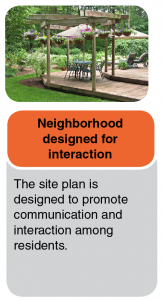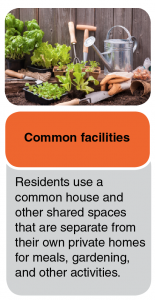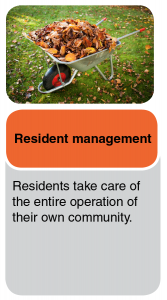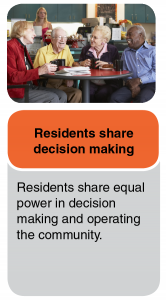Senior Cohousing: Creating Connections and Maintaining Autonomy
Older Adults and Living at Home
Aging in Place
Aging in place is the ability to live at home without help for as long as possible. Modifications to the home may make aging in place feasible. Aging in place can also refer to relocating to housing that provides a supportive environment for aging.
From Loneliness to Connections
Many older adults age in place. Some live alone. At times, older adults living alone experience loneliness and isolation. Not being able to participate in activities with others can also increase loneliness. Without connections, loneliness can occur. Changing or ending relationships can increase loneliness.
- Emotional loneliness is lack of close attachment (example: loss of a spouse)
- Social loneliness is lack of an adequate circle of friends
Loneliness can affect quality of life. Living with others can create connections that lead to community. Community is important for older adults.
Autonomy
Autonomy is the state of being self-governing. Older adults that are autonomous are able to make their own decisions. Self-governance is important for independence. Older adults want choices. Choices lead to independence. Many older adults want to remain independent. Housing choice can support independence.
A New Way of Living
Cohousing is a type of planned housing. In cohousing, older adults remain connected and independent. Aging in place in a cohousing community is an alternative to aging in place in a traditional single family home. Cohousing communities offer a place where residents can bond with each other. Cohousing can support social, emotional and physical well-being.
Features of Cohousing
Communities feature private homes, common houses and shared outdoor spaces. The six elements of cohousing are shown in Figure 1. (Durrett, 2009; SAGE Cohousing International, 2015; The Cohousing Association of the United States, 2014).
Shared beliefs may bring people together to form a community. Some communities may incorporate all or some cohousing elements. In the U.S., senior cohousing communities include those shown in Figure 1. For more information about these communities, visit their websites.
- Glacier Circle Community (Davis, CA)
- Wolf Creek Lodge (Grass Valley, CA)
- Silver Sage Village (Boulder, CO)
- Washington Village (Boulder, CO)
- Valverde Commons (Taos, NM)
- Oakcreek Community (Stillwater, OK)
- Elderspirit Community (Abingdon, VA)
Connections and autonomy
Cohousing communities encourage a sense of belonging. Residents are key players. Involvement with others adds value to later life.
Conclusion
Quality of life is important to older adults. Quality of life can help older adults live longer, healthier lives. Cohousing can connect and support older adults. Living in a cohousing community can add value to these important years. Adults are able to successfully age in place in this new way of living. Consider senior cohousing as an option for aging in place.






Figure 1. Features of Cohousing. Features of Cohousing.
Reviewers:
Llola Matthews, Oklahoma Home and Community Education, Inc.
Brenda Miller, Oklahoma Cooperative Extension Service
Gale Mills, Oklahoma Cooperative Extension Service
Lisa Wiebe, Integral Living Solutions, LLC
References
Durrett, C. (2009). The senior cohousing handbook: A community approach to independant
living (2nd ed.). Gabriola Island, British Columbia, Canada: New Society Publishers.
SAGE Cohousing International. (2015). Characteristics of cohousing. Retrieved November,
2015, from
The Cohousing Association of the United States. (2014). What is cohousing? Retrieved
November, 2015
Mihyun Kang
Associate Professor
Gina Peek
Assistant Professor and Extension Housing and
Consumer Specialist
Emily Roberts
Assistant Professor
